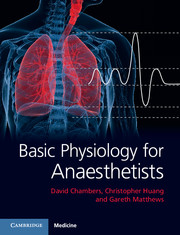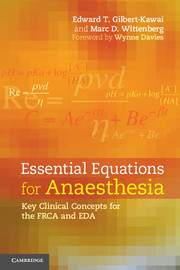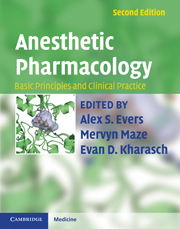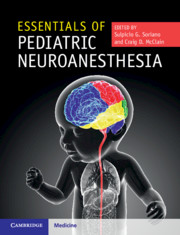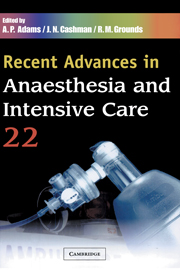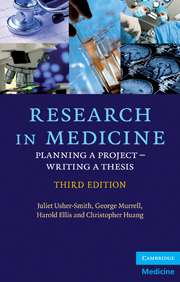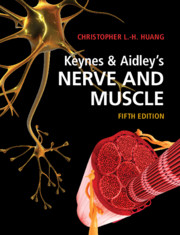Basic Physiology for Anaesthetists
$86.99 USD
- Authors:
- David Chambers, North West School of Anaesthesia
- Christopher Huang, Murray Edwards College, Cambridge
- Gareth Matthews, Murray Edwards College, Cambridge
- Date Published: January 2015
- availability: This ISBN is for an eBook version which is distributed on our behalf by a third party.
- format: Adobe eBook Reader
- isbn: 9781316057490
Find out more about Cambridge eBooks
$
86.99 USD
Adobe eBook Reader
Looking for an inspection copy?
This title is not currently available on inspection
-
Every trainee in anaesthesia requires a thorough understanding of basic physiology and its application to clinical practice. This comprehensively illustrated textbook bridges the gap between medical school and reference scientific texts. It covers the physiology requirements of the Primary FRCA examination syllabus. Chapters are organised by organ system, with particular emphasis given to the respiratory, cardiovascular and nervous systems. The practical question-and-answer format helps the reader prepare for the oral examination, while 'clinical relevance' boxes translate the physiological concepts to clinical practice. The authors include two medical physiologists and a Specialty Registrar in anaesthesia, and thereby bring a unique blend of expertise. This ensures that the book is up-to-date, accessible, and pitched appropriately for the trainee anaesthetist. Packed with easily understood, up-to-date and clinically relevant material, this convenient volume provides an essential 'one-stop' resource in physiology for junior anaesthetists.
Read more- Contains over 160 diagrams, with key features clearly illustrated, aiding understanding of the physiological concepts and permitting easy replication in an examination setting
- Clinical relevance boxes relate basic science to everyday anaesthetic practice
- Chapters are presented in a question-and-answer format, permitting the anaesthetic trainee to envisage how physiology questions may be asked in an oral examination
Reviews & endorsements
'… an excellent text … This is a good book presenting basic science clearly and constructively for junior anaesthetists preparing for speciality examinations (FRCA).' British Medical Association Programme and Award Winners 2016
Customer reviews
Not yet reviewed
Be the first to review
Review was not posted due to profanity
×Product details
- Date Published: January 2015
- format: Adobe eBook Reader
- isbn: 9781316057490
- contains: 161 b/w illus. 7 tables
- availability: This ISBN is for an eBook version which is distributed on our behalf by a third party.
Table of Contents
Foreword
Preface
Part I. The Basics:
1. General organisation of the body
2. Cell components and function
3. Genetics
4. The cell membrane
5. Enzymes
Part II. Respiratory Physiology:
6. Lung anatomy and function
7. Oxygen transport
8. Carbon dioxide transport
9. Alveolar diffusion
10. Ventilation and dead space
11. Static lung volumes
12. Spirometry
13. Hypoxia and shunts
14. Ventilation-perfusion relationships
15. West Zones
16. Oxygen delivery and demand
17. Alveolar gas equation
18. Oxygen cascade
19. Lung compliance
20. Work of breathing
21. Control of ventilation
22. Pulmonary circulation
23. Oxygen toxicity
24. Ventilatory failure
25. Anaesthesia and the lung
Part III. Cardiovascular Physiology:
26. Cardiac anatomy and function
27. Cardiac cycle
28. Cardiac output and its measurement
29. Starling's law and cardiac dysfunction
30. Pressure-volume loops
31. Systemic circulation
32. Arterial system
33. Arterial pressure waveforms
34. Capillaries and endothelium
35. Venous system
36. Venous pressure waveforms
37. Lymphatics
38. Cardiovascular reflexes
39. Valsalva manoeuvre
40. Exercise physiology
Part IV. Neurophysiology:
41. Neuronal structure and function
42. The brain
43. Cerebrospinous fluid
44. Blood brain barrier
45. Cerebral blood flow
46. Intracranial pressure and head injury
47. The spinal cord
48. Resting membrane potential
49. Nerve action potential and propagation
50. Synapses and the neuromuscular junction
51. Skeletal muscle
52. Muscle spindles and Golgi tendon organs
53. Smooth muscle
54. Cardiac muscle
55. The electrocardiogram
56. Autonomic nervous system
57. Pain physiology
Part V. Gastrointestinal Tract:
58. Saliva, oesophagus and swallowing
59. Stomach and vomiting
60. Gastrointestinal digestion and absorption
61. Liver anatomy and blood supply
62. Liver function
Part VI. Kidney and Body Fluids:
63. Renal function, anatomy and blood flow
64. Renal filtration and reabsorption
65. Renal regulation of water and electrolyte balance
66. Acid-base physiology
Part VII. Blood and Immune System:
67. Haemostasis
68. Transfusion
69. Anaemia and polycythaemia
70. Immune system
71. Plasma constituents
Part VIII. Energy Balance:
72. Metabolism
73. Starvation
74. Stress response
Part IX. Endocrine Physiology:
75. Hypothalamus and pituitary
76. Thyroid, parathyroid and adrenal
Part X. Developmental Physiology:
77. Maternal physiology during pregnancy
78. Fetal physiology
79. Paediatric physiology
80. Physiology of ageing
Part XI. Environmental Physiology:
81. Altitude
82. Diving
83. Temperature regulation
Index.
Sorry, this resource is locked
Please register or sign in to request access. If you are having problems accessing these resources please email [email protected]
Register Sign in» Proceed
You are now leaving the Cambridge University Press website. Your eBook purchase and download will be completed by our partner www.ebooks.com. Please see the permission section of the www.ebooks.com catalogue page for details of the print & copy limits on our eBooks.
Continue ×Are you sure you want to delete your account?
This cannot be undone.
Thank you for your feedback which will help us improve our service.
If you requested a response, we will make sure to get back to you shortly.
×
